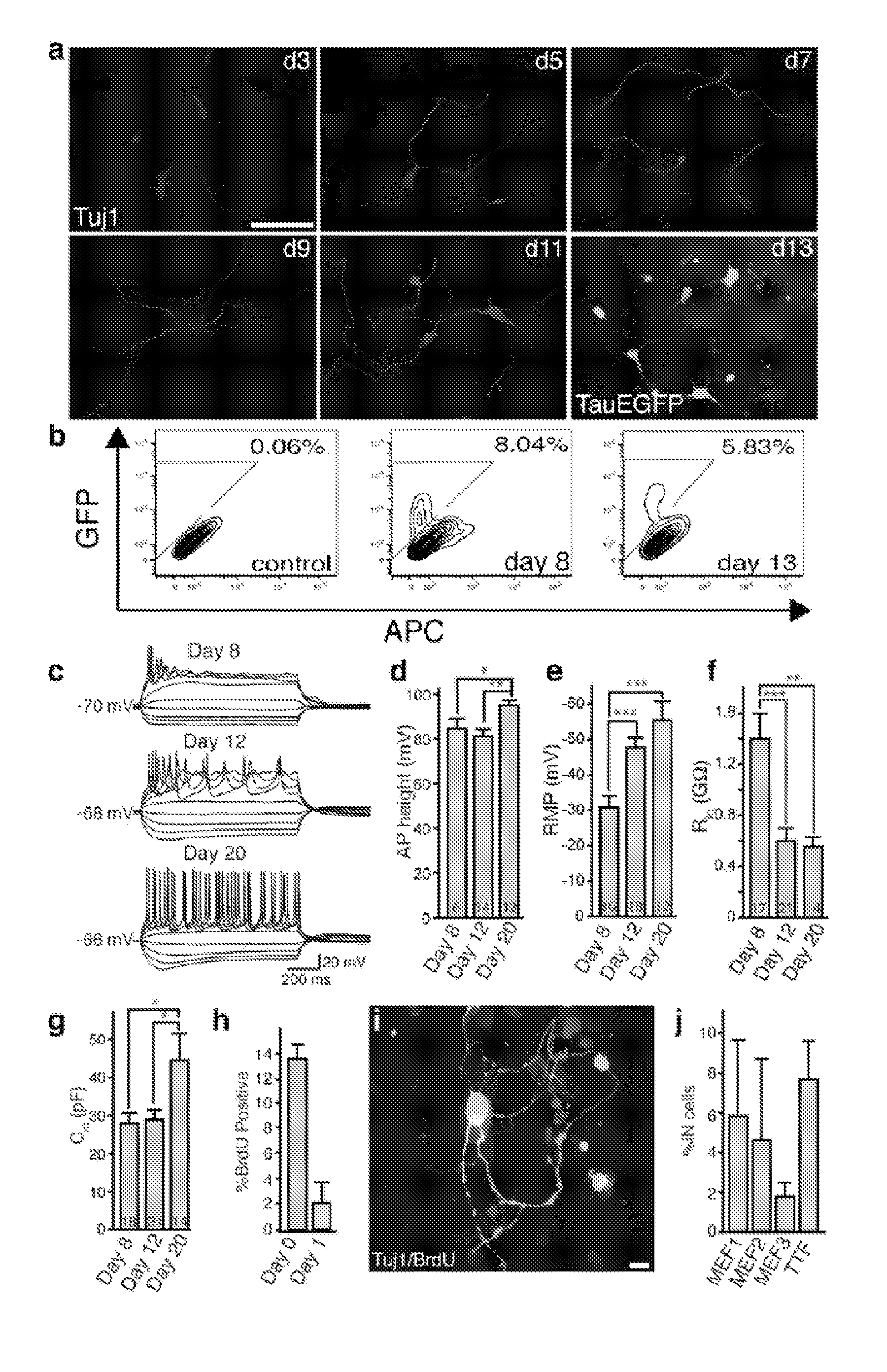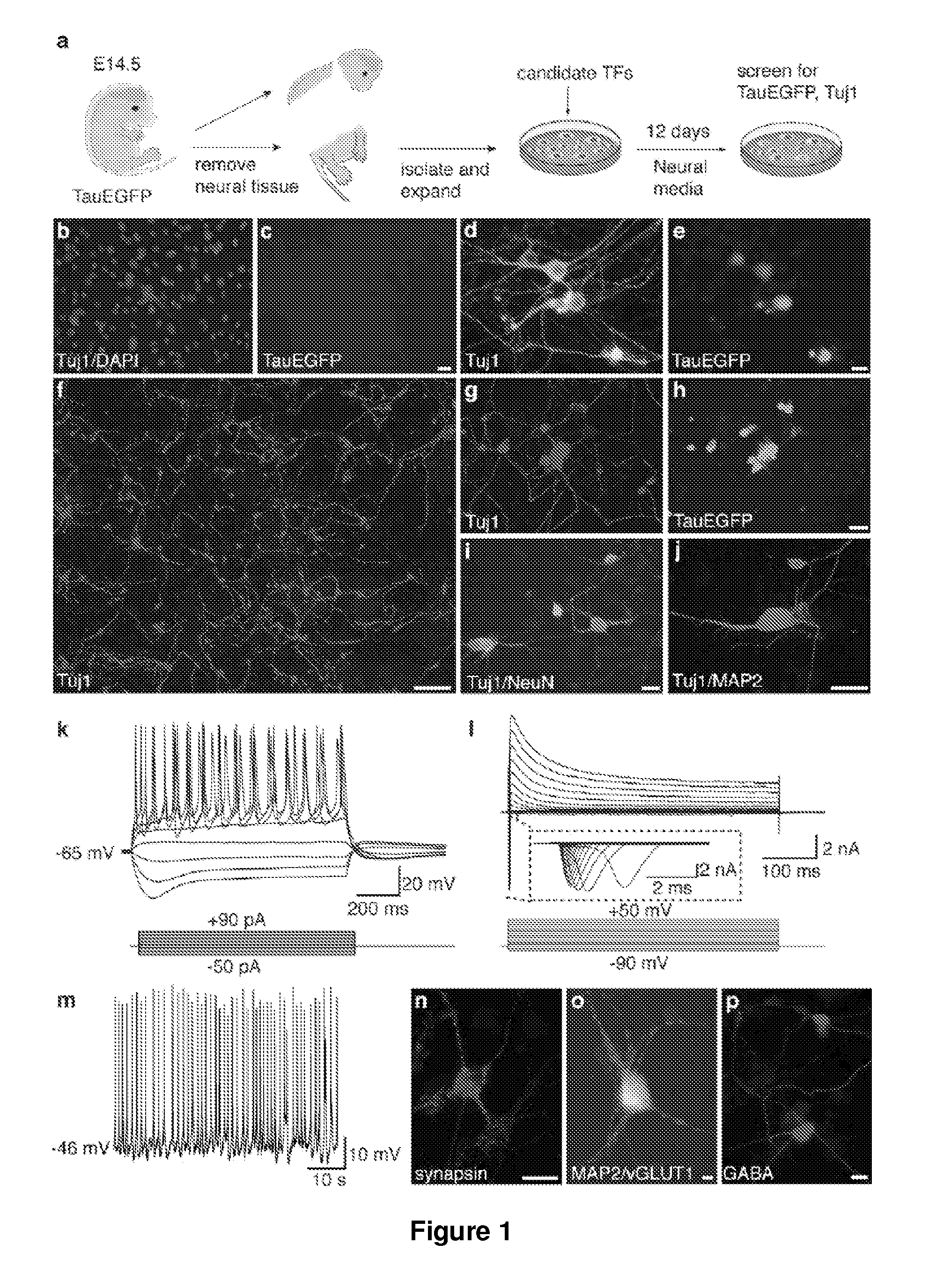Direct conversion of cells to cells of other lineages
a technology of cell and cell lineage, applied in the field of direct conversion of cells to cells of other lineages, can solve the problems of slow and inefficient reprogramming into embryonic state with subsequent differentiation of embryonic-state cells into cells of the central nervous system, and requires significant time and manipulation in vitro
- Summary
- Abstract
- Description
- Claims
- Application Information
AI Technical Summary
Benefits of technology
Problems solved by technology
Method used
Image
Examples
example 1
Induction of Neuronal Cells from Mouse Fibroblasts
Materials and Methods
[0186]Embryonic Fibroblast Isolation.
[0187]Homozygous TauEGFP knock-in mice (Tucker, K. L., et al. (2001) Nat Neurosci 4, 29-37) were purchased from the Jackson Laboratories and bred with C57B16 mice (Taconic) to generate TauEGFP heterozygous embryos. Balb / c mice were purchased from Taconic. Rosa26-rtTA mice were obtained from Rudolf Jaenisch (Beard, C., et al. (2006) Genesis 44, 23-8). MEFs were isolated from E14.5 embryos under a dissection microscope (Leica). The head, vertebral column (containing the spinal cord), dorsal root ganglia, and all internal organs were removed and discarded to ensure the removal of all cells with neurogenic potential from the cultures. The remaining tissue was manually dissociated and incubated in 0.25% Trypsin (Sigma) for 10-15 minutes to create a single cell suspension. The cells from each embryo were plated onto a 15 cm tissue culture dish in MEF media (Dulbecco's Modified Eagle...
example 2
Induced Oligodendrocyte Production
[0245]10 candidate genes were screened for oligodendrocytes induction: Ascl1; NRx6-1 Myt1; Zfp536; NRx2-2; Olig2; Olig1; Sox10; NRx6-2; MRF. EGFP was induced as an aid to visualization. All ten transcription factors, all of which are known to play a role in oligodendrocyte specification or differentiation, were screened in wild-type mouse embryonic fibroblasts (MEFs). Strikingly, when all ten genes were combined, we observed cells with characteristic oligodendrocyte morphology after 12 days of transgene expression. These cells also expressed the oligodendrocyte specific surface marker O4, which marks terminally differentiating OPCs and. In parallel, we examined the effect of removing groups of genes from this initial pool of ten, and we were able to derive oligodendrocytes from some pools of six genes. These data indicate that combination(s) of the ten transcription factors can induce oligodendrocyte-like cells from embryonic fibroblast cultures.
example 3
Neural Progenitor Cell Induction
[0246]Six factors were tested for induction of neural progenitor cells: Sox2, Lhx2, FoxG1, Id4, Rfx4, and Zic1. Colonies form after infection with a combination of the 6 NSC reprogramming factors showing a morphology similar to a neurosphere, as it would appear after expansion of brain-derived neural stem cells. A large fraction of the cells in that colony express endogenous Sox2 as judged from EGFP fluorescence originating from the Sox2:EGFP allele knocked into the Sox2 locus. About 3 weeks after infection with the NSCR factors a large number of neural stem cell marker genes are induced.
PUM
| Property | Measurement | Unit |
|---|---|---|
| resting membrane potential | aaaaa | aaaaa |
| surface area | aaaaa | aaaaa |
| voltage | aaaaa | aaaaa |
Abstract
Description
Claims
Application Information
 Login to View More
Login to View More - R&D
- Intellectual Property
- Life Sciences
- Materials
- Tech Scout
- Unparalleled Data Quality
- Higher Quality Content
- 60% Fewer Hallucinations
Browse by: Latest US Patents, China's latest patents, Technical Efficacy Thesaurus, Application Domain, Technology Topic, Popular Technical Reports.
© 2025 PatSnap. All rights reserved.Legal|Privacy policy|Modern Slavery Act Transparency Statement|Sitemap|About US| Contact US: help@patsnap.com



